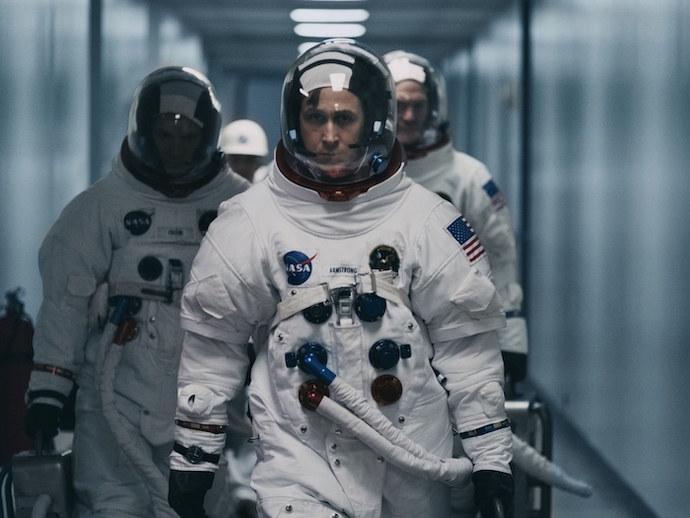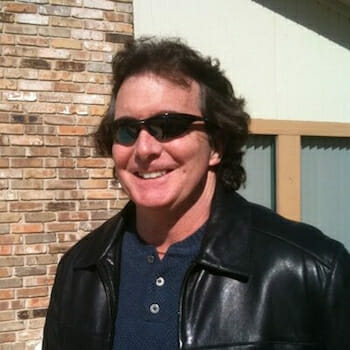Damien Chazelle Takes Us to the Moon with ‘First Man’
“That’s one small step for [a] man, one giant leap for mankind.” Every junior high student learns that Neil Armstrong spoke those words when he became the first person to walk on the Moon’s surface in 1969. So while his words are etched into our minds and the televised visuals of the historic event are seared into our corneas, most of us know little of the man who is renowned as an American hero. In First Man, director Damien Chazelle (La La Land, Whiplash) finds a way to personalize a man’s story without sacrificing the corresponding grandiose theatre and immense danger.
Kicking off with one of the most intense cinematic sequences ever, the film puts us inside the LLRV (Lunar Landing Research Vehicle) with Armstrong in 1961 as he bounces off the atmosphere and rockets towards near certain death. This opening makes the statement that this is no ordinary man, and this is no ordinary movie…and we are now prepared to hold on tight! Based on James R. Hansen’s book, the only biography Armstrong authorized, the script from Oscar winner Josh Singer (Spotlight) expertly balances the test pilot/astronaut portion with the character study/personality of the man. Intensity is on display throughout – whether in a capsule or during family time.
Ryan Gosling stars as Neil Armstrong, and the story tracks him from 1961 through that famous moment in 1969. What we see is a man who was first an engineer, and then a pilot. A man whose intellect and nerve allowed him to be part of the second group of pilots selected for NASA’s astronaut program in 1962. The first group was the Mercury Seven. He was also a man emotionally devastated by the death of his young daughter Karen (from a brain tumor) and the numerous deaths of friends and associates in the space program. The film clearly shows how he was impacted.

Proving true JFK’s proclamation that the driving force wasn’t that it was easy, but rather that it was quite hard, we glimpse some of the inner workings of NASA, and what becomes clear that the space program was high stakes gambling filled with huge risks – all for a space race against the Russians that was motivated by ego and national pride. Daily danger was part of the job, as was the claustrophobia that comes with sitting in tin can space capsules being monitored by computers far less powerful than the cell phone you are likely using to read this. Armstrong’s claustrophobia somehow seemed less apparent during his flights than during press conferences or sitting at the kitchen table with his family – providing even more insight into the man.
Claire Foy (“The Crown”) plays Janet Armstrong, the strong-for-the-kids while mostly suffering homemaker wife. Ms. Foy does a nice job of conveying the emotional turmoil that goes with being an astronaut’s wife, and having no one to share the uncertainty and worry with. Jason Clarke plays Ed White, the first American to walk in space (Gemini 4) and Armstrong’s neighbor and close friend. Olivia Hamilton plays his wife Janet, while Kyle Chandler plays Deke Slayton, and Corey Stoll offers up a not so complimentary portrayal of Buzz Aldrin. Other familiar faces in the cast include Shea Whigham as Gus Grissom, Christopher Abbott as Dave Scott, Pablo Schreiber as Jim Lovell (played by Tom Hanks in Apollo 13), Ethan Embry, Ciaran Hinds, Patrick Fugit, Lukas Haas, Cory Michael Smith, Brian D’Arcy James, and Leon Bridges.
Meticulous attention to details of the era include kids that actually ask to go play outdoors (and aren’t overly impressed with astronaut dads). The sound design and set designs are phenomenal and complement the outstanding cinematography of Linus Sandgren (Oscar winner for La La Land). The abundance of close-ups allow for an intimacy that makes the awe-inspiring space sequences even more breath-taking. Actual historic space audio is used whenever possible, and director Chazelle doesn’t shy away from showing us the “other side” of the space program: Gil Scott-Heron’s “Whitey’s on the Moon,” writer Kurt Vonnegut publicly questioning the program, and many citizens wondering why so much money is being spent on rockets while there were so many other areas (including Vietnam) in need of attention.
The humor is often quite sly, including a scene where his competitive applicants shrug off Armstrong as only a “civilian,” unaware of his remarkable service and record in the Korean War as a Navy Fighter Pilot. Gosling’s quietly intense portrayal of Armstrong could be termed constrained, but it’s quite fitting given his subject. Composer Justin Hurwitz (Oscar winner for La La Land) delivers an unusual but fitting score, and we can’t help but realize this would make a terrific trilogy bookended by The Right Stuff (1983) and Apollo 13 (1995). Chazelle presents a fitting bio of a true American hero (and yes, we can see the flag on the moon), while also giving us a look at the harrowing process of putting folks into space. It’s on us to decide if it’s worth it, but leaves no doubt that President Kennedy was right…it is hard.

